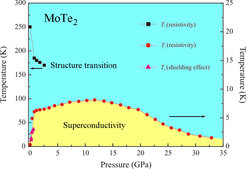Pressemeldung:
Molybdenum Ditelluride – a Superconducting Weyl Semimetal
In the last years, new states of quantum matter in solids have attracted great research interest. For example, topological insulators – solids with insulating interior but metallic conduction on the surface – are promising candidates for novel spin-electronics applications (spintronics) and quantum computing. This class of materials opens new pathways to designed properties based on the topology of the electronic properties. The discovery of such novel quantum matter was inspired by ideas originating from high-energy physics and cosmology. One example was predicted by the German physicist Hermann Weyl about 100 years ago. Weyl’s predicted state was recently realized in solid matter as the topological Weyl semimetal (TWS). The electronic structure of a TWS possesses Weyl points embracing linear band dispersion along all three momentum directions. In contrast to conventional metals or semimetals, a TWS exhibits non-trivial surface states that form peculiar “Fermi-arcs.” The special electronic structure of TWS materials can give rise to intriguing electronic properties, such as chiral magnetic effects, negative magnetoresistance, and the quantum anomalous Hall effect.
The theoretical group led by Dr. Binghai Yan from the MPI for Chemical Physics of Solids (MPI-CPfS) in Dresden, has found by calculations of the electronic structure that the dichalcogenide compound MoTe2 (molybdenum ditelluride) belongs to the class of Weyl semimetals. This prediction was recently confirmed by the experimental observation of Fermi arcs. Dichalcogenides are especially interesting since they form a unique structural toolbox to realize many exciting physical and chemical properties and offer the opportunity to find a multifunctional Weyl semimetal. Now, experimental studies of the electronic transport were carried out in the high-pressure group led by Dr. Sergiy Medvedev at MPI-CPfS. They revealed that MoTe2 possesses another fascinating property: superconductivity - the complete loss of electrical resistance below a certain temperature Tc. The work was carried out in cooperation with scientists from Princeton University, USA, the MPI for Microstructural Research in Halle, Germany, the Dresden High Magnetic Field Laboratory, and the European Synchrotron Radiation Facility, France.
Although the Tc in MoTe2 is quite low (about 0.1 K, only), electrical resistivity measurements have shown that the transition temperature can be dramatically enhanced by application of moderate pressures. At a pressure of 11.7 GPa the Tc grows to a maximum value of 8.2 K. An analysis of the changes of the crystal structure of MoTe2 under such high pressure indicates that the major enhancement of the Tc occurs within the topologically nontrivial phase. This strong pressure dependence of the Tc reflects the fact that the electronic band structure of a Weyl semimetal is extremely sensitive to changes in the interatomic distances.
“Dichalcogenides provide an excellent platform to search for Majorana fermions, another interesting quantum state predicted in the last century by Ettore Majorana” says Prof. Claudia Felser, director of the Solid State Chemistry department and managing director of MPI-CPfS, ”We think that the material for a future quantum computer might be among the dichalcogenides.”
The results are published in Nature Communications (March 14. 2016)
SM / CPfS

Electronic and structural phase diagram of the superconducting Weyl-semimetal MoTe2.











